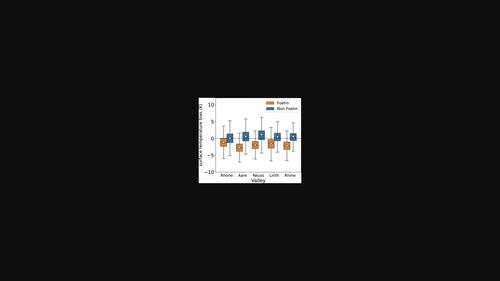A station‐based evaluation of near‐surface south foehn evolution in COSMO‐1
IF 3
3区 地球科学
Q2 METEOROLOGY & ATMOSPHERIC SCIENCES
引用次数: 0
Abstract
This study investigates the skill of the COSMO model (v5.7) at 1.1 km horizontal grid size in simulating the near‐surface foehn properties and evolution for five south foehn events and a 5‐year‐long climatology. A significant near‐surface cold bias is found during foehn, with an average bias of ‐3 K in the Rhine Valley in the five foehn cases, and of ‐1.8 K in the major northern foehn valleys in the 5‐year foehn climatology. The cold bias tends to be larger in the stronger and moister deep foehn events. Sensitivity experiments are carried out to examine the possible causes of the cold bias, including changes to the parameterization of the land‐atmosphere interaction, to the 1D turbulence parameterization, and to the horizontal grid spacing. Most sensitivity experiments have only a very minor impact on the cold bias, except for the model run with a horizontal grid spacing of 550 m. The 550 m COSMO run shows a reduced cold bias during foehn hours and also an improvement in the simulated foehn duration and northward foehn extent. By inspecting the vertical dimension, we found that the near‐surface cold bias downstream might partly originate upstream. A further contribution to the downstream cold bias is likely due to insufficient vertical mixing in the foehn flow. The latter is possibly enhanced in the 550 m model run, leading to a less stably stratified atmosphere in the lower few hundred meters of the atmosphere and a reduction of the reported model cold bias. This article is protected by copyright. All rights reserved.

COSMO - 1近地表南风演化的台站评价
本文研究了在1.1 km水平网格尺度上COSMO模式(v5.7)在模拟5次南焚风事件和5年气候条件下近地表焚风性质和演变的能力。在焚风期间发现了明显的近地表冷偏,在5年的焚风气候中,莱茵河谷的平均偏度为‐3 K,在主要的北部焚风山谷中为‐1.8 K。在较强、较湿的深风事件中,冷偏倾向较大。进行了敏感性实验以检验冷偏的可能原因,包括陆地-大气相互作用参数化的变化、一维湍流参数化的变化和水平网格间距的变化。除了水平网格间距为550 m的模型运行外,大多数灵敏度实验对冷偏差的影响很小。550 m COSMO运行表明,焚风时间的冷偏减小,模拟焚风持续时间和向北的焚风范围也有所改善。通过对垂直尺度的考察,我们发现下游近地表冷偏可能部分来源于上游。对下游冷偏的进一步贡献可能是由于焚风流的垂直混合不足。后者可能在550米模式运行中增强,导致低层几百米的大气分层不太稳定,并减少了报告的模式冷偏。这篇文章受版权保护。版权所有。
本文章由计算机程序翻译,如有差异,请以英文原文为准。
求助全文
约1分钟内获得全文
求助全文
来源期刊
CiteScore
16.80
自引率
4.50%
发文量
163
审稿时长
3-8 weeks
期刊介绍:
The Quarterly Journal of the Royal Meteorological Society is a journal published by the Royal Meteorological Society. It aims to communicate and document new research in the atmospheric sciences and related fields. The journal is considered one of the leading publications in meteorology worldwide. It accepts articles, comprehensive review articles, and comments on published papers. It is published eight times a year, with additional special issues.
The Quarterly Journal has a wide readership of scientists in the atmospheric and related fields. It is indexed and abstracted in various databases, including Advanced Polymers Abstracts, Agricultural Engineering Abstracts, CAB Abstracts, CABDirect, COMPENDEX, CSA Civil Engineering Abstracts, Earthquake Engineering Abstracts, Engineered Materials Abstracts, Science Citation Index, SCOPUS, Web of Science, and more.

 求助内容:
求助内容: 应助结果提醒方式:
应助结果提醒方式:


